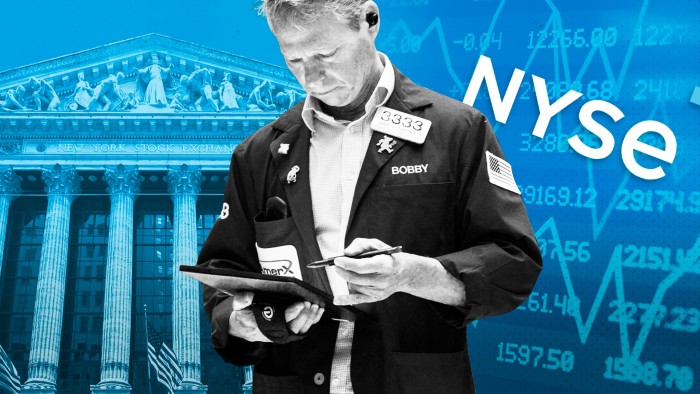Admit it, markets are in a sweet spot


Roula Khalaf, Editor of the FT, selects her favourite stories in this weekly newsletter.
It is really starting to feel like time for a lot of investors to take a deep breath, swallow their pride, and admit their grand theories about an impending stock market crash might be early. And by early, I mean wrong.
All year, despite expectations to the contrary from pretty much every bank and prominent investment house, key equity markets have ripped higher. Sure, you can quibble with weird details like the outsized impact of just a few US tech stocks, but the numbers are the numbers: 18 per cent on the S&P 500 this year and 36 per cent (not a typo) on the Nasdaq Composite. Even Japan, that perennial underperformer, is up 18 per cent, and several European indices are well in to double figures.
The latest injection of good vibes has come from US inflation data released on Wednesday. Those dark days of 9 per cent inflation just over a year ago are now well behind us. Instead the rate dropped to just 3 per cent in June — the lowest point in two years. That has been enough to propel the S&P 500 to its strongest level in 15 months.
Hedge funds and other big investors were simply not ready for this, one banker told me. That means the buses on this rally “are not full”. All things being equal that means it could have further to run, whether the pessimists want it to or not. It is a classic pain trade.
“A recession remains our base case,” said Wolf von Rotberg, an equity strategist at private bank J Safra Sarasin in Zurich. “But I must admit the inflation number this week makes us at least think about alternative scenarios.”
The inflation numbers matter in large part because if the pullback is for real, that means the Federal Reserve can take its foot off the rate-rising gas and potentially even throw its aggressive tightening into reverse without ever triggering the dreaded hard landing that fund managers have feared.
The futures markets indicate that investors are expecting one more quarter-point rise from the Fed by the autumn and then a decent series of cuts over the next year and a bit.
One thing to remember here: that is not necessarily a perfect view on what investors honestly think the Fed is going to do. Tail-risk hedges on massive rate cuts to deal with a huge recession can easily mess with the signal. Still, again, it is hard to argue with the numbers.
Bob Prince, for one, is urging caution. The co-chief investment officer at Bridgewater Associates — one of the world’s biggest hedge funds — told us this week that “the Fed is not going to cut”. “They are not going to do what is priced in,” he said of market expectations of a rate cut, adding he has been “positioned for a tightening cycle”. He clearly has a point, but this is becoming an increasingly uncomfortable place to be.
JPMorgan Asset Management is also not buying the hype. In its outlook for the rest of 2023 this week (shortly before the release of US inflation data) it said the upbeat performance of risky markets this year is simply “too good to be true”.
Overly rosy stock markets, and relative strength at even the riskier end of the corporate bond market are making it nervous. “We feel markets are much less prepared for the slowdown that we still think is necessary” to bring inflation truly and durably under control, said Hugh Gimber, a global markets strategist at the investment house. Think like an armadillo, ready to quickly roll up in to a shielded ball when a threat arrives, he suggested. “We are uncomfortable that markets are so cheery and think it’s time to take some chips off the table.”
The rally in a small number of big tech stocks is holding up a lot of sky for now, he added, but the Covid era with its lockdowns was the first time tech dodged the impact of a real recession. If one did finally bite, it is easy to imagine a lot of damage to the overall market.
Von Rotberg at J Safra Sarasin also echoed that point — buying tech stocks has been a great defensive strategy of late, but that’s the exception rather than the norm, and it “could flip back to the cyclical bucket”.
But it does not take a huge amount of squinting to see that, aside from the UK, with its ugly growth and inflation outlook, we are actually in a very sweet spot.
“We have got the most amazing Goldilocks situation,” said Fahad Kamal, chief investment officer at private bank SG Kleinwort Hambros. “The economy is not too bad, people have jobs, the consumer is very well anchored. Getting 6 per cent more in your pay has a more powerful psychological impact than paying 8 per cent more at the shop. We’re mammals. It’s more visceral.”
The decline in US inflation “does not feel too bad”, Kamal said, with a dollop of understatement. And if that were not enough, we have seen, in the shortlived US banking crisis earlier this year, that the Fed is still willing and able to extinguish fires with its balance sheet. “We have got all of that in place, and the beautiful Fed backstop, just in case,” said Kamal. When he puts it like that, what’s not to like? Pessimists should brace for the prospect of the pain trade getting more painful.
katie.martin@ft.com
Comments